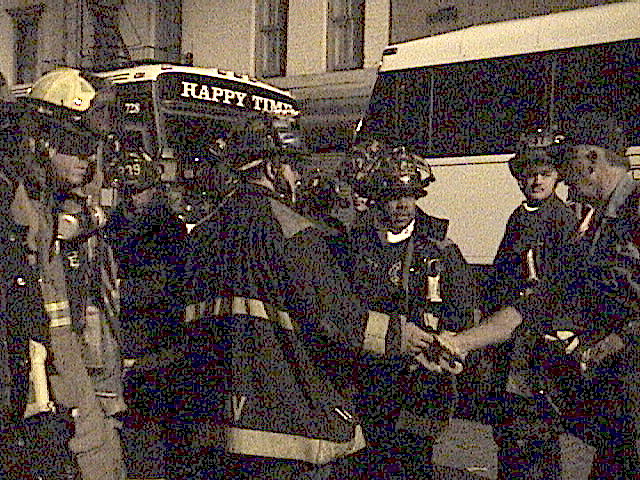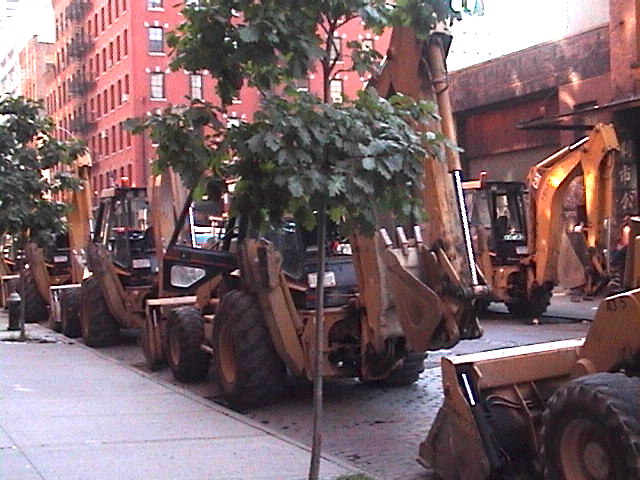by Thea Halo
The following was written on September 13, 2001.

For those of you who are concerned and interested in what is happening in downtown NYC, I finally went back on Thursday to check on my loft. I live in Tribeca about 10 blocks from the Trade Center site. I had left my windows open when I left town, so I was concerned about smoke and debris. The drive back on Thursday afternoon was unobstructed, since the bridges and tunnels had only recently been reopened. At 21st Street, traffic was diverted away from the West Side Highway. At 14th Street, the streets were closed off to regular traffic. I parked my car on 8th Avenue and 18th Street and walked home, about two miles.
At 14th Street there was a check-point where one had to show identification to prove he or she lived or worked below 14th Street. As I passed through Greenwich Village, smoke with an odor of burning rubber and plastics, began to fill the air. Passers-by commented that the fires must have resumed because the smoke had not reached so far uptown before. But a wind was blowing from the south, bringing the foul smelling smoke with it.
Some restaurants were closed in Greenwich Village, but many were open for business. The sidewalk tables at the White Horse Tavern on 8th Avenue, about 1 1/2 miles from the site, were full of people eating an early dinner or having drinks. Signs in many restaurant windows invited police and fire fighters to come in for drinks and snacks. The most dramatic change that far downtown was the lack of car traffic on the streets, but the streets were still populated with people. Or perhaps the most dramatic change was that people looked each other in the eyes, bound together by a common feeling of loss.
By Canal Street the people on the streets had diminished to only a few; an occasional group of relief workers wearing masks walking their way uptown away from the scene, or some stragglers pulling their luggage towards 14th Street. At Canal Street there was another check-point where again one had to show identification. Canal Street was lined with trucks and buses of various descriptions in which relief workers or other equipment had been transported. Further south, a street was lined with parked bulldozers. Another contained police vans and more buses, that had brought relief workers to the scene. The smoke had thickened considerably. On passing a relief worker who was loading a truck with water, soft drinks and masks, he asked if I wanted a mask. I had been holding my sweater over my nose to block out the thickening smoke. I gratefully accepted and continued to my street.
Walking down Greenwich Street below Canal, I could see the cloud of thick yellow smoke where the Trade Centers had once dominated the skyline and filled in the space between the buildings on either side of Greenwich Street. It was difficult to adjust to the empty space there. On my street, other trucks were parked on both sides. I am told they used my street to lay out bodies at one time during the rescue operations. Volunteers with masks hung out outside The Tribeca Grill, a neighborhood restaurant on my street that seemed to be open for the sole purpose of accommodating relief workers. Most of the relief workers that far south stood at check points or waited to be of use. I heard a great rumble and was told that part of the teetering wall of one of the buildings had finally come crashing down. Of course, the mood was somber.
Upstairs my loft was full of smoke and a layer of dust from the disaster, covered everything. But the windows were still in tact and only a few papers had blown off the counter. I looked out of the windows to the empty smoke filled space that used to house the great rectangles of the World Trade Centers, and again the eerie knowledge that these two great monuments of our city were gone was difficult to grasp.
I realized how much a part of us they had become over the years; how much they had dominated every visual aspect of the skyline and the downtown scene. They were the landmarks one told visitors to look for to get their bearings when they emerged from subways; the landmarks that would silently inform them which way was south, and consequently, which way was east or west. They were the landmarks on which one blamed the wind tunnel that blew diagonally uptown, so that on windy days one could actually be blown off one’s feet at 6th Avenue and White Street when taking the next step to cross the road. They were the landmarks from which Godzilla had dangled, and from which daredevils had performed their dare-devilish feats of bravery and skill. They were the landmarks that housed a diverse array of peoples in business, government, and the arts. Recently, artist’s studios had been offered at the Trade Center by one of the state or city arts counsels. I would like to think this last was meant as a thank-you to the many artists whose labors and love of lower Manhattan had brought the districts, now known as SoHo and Tribeca, back to life over the last thirty-five years.
The Trade Centers were monuments of vast strength and proportion, dwarfing even the tallest surrounding skyscrapers, yet they appeared to be held up by the thinnest possible supports, like broad-backed spiders on needle-point legs. At times they disappeared in a cloud of mist, but always emerged again, gleaming with sparks of silver as the sun burned the mist away. They had always been there in the twenty-seven years I have lived in their grace. They were there on waking with their spiral antenna poking at a cobalt sky, or spearing gray, slumbering, clouds. And they were there at bedtime as the lights in thousands of their windows illuminated the night.
What had begun forty years ago as the butt of jokes and criticism for the designers and financiers of these nondescript monuments to America’s financial domination, had somehow over the years become less like real estate, and more like old trusted friends; always there, always giving comfort that some things never change. With a capacity the size of small vertical cities, housing upward of 50,000 people, they became living, breathing entities at the edge of Manhattan; guardians that oversaw the whole of the island and outlying boroughs and states. And like parental figures, they had achieved a mysticism akin to the symbol of the flag still flying as bombs burst in the night.
As I looked up from my debris encrusted windows to where the World Trade Centers once stood, I now saw only a cloud of yellow smoke rubbing its billowing haunches on a brilliant blue sky. It was difficult to imagine these friends would not emerge victorious this time as they had emerged from the mist so many times before. It was even more difficult to imagine that the remains of so many of their inhabitants, people from every spectrum of our great city, nation, and globe, who had breathed life each day into the halls and cubicles of these two great entities, were now inexorably mixed with the dust of their tragic demise.
I offer my condolences to the multitude of people who tragically and needlessly lost family, friends, and co-workers to this senseless terror. And I offer my condolences to our great city for the demise of two beacons that had served as reminders to us and the world, of the extraordinary human capacity to achieve great feats, and that now remind us how fragile life is, and how tentative is our moment on the earth, even in the face of seeming strengths and apparent superhuman achievements.
As no other tragedy of recent times, this for me brings to mind John Donne’s famous Meditation XVII that “No man is an island entire to itself; every man is a piece of the continent, a part of the main …. Any man’s death diminishes me because I am involved in mankind; and therefore never send to know for whom the bell tolls; it tolls for thee.”
In demonstrating solidarity with Americans in this time of mourning, the world demonstrates the spirit of Donne’s sentiments that we are all “a part of the main.” I can only hope that in the days, weeks, and months ahead, when more talk of war whips the country into a frenzy of revenge, we can all remember that John Donne’s “every man”, knows no country of origin; no ethnic, racial, or religious separation. Perhaps heeding Donne’s sentiment can be the greatest homage one can pay to the victims of this sad event.
Photos by Thea Halo
Update: September 11, 2020.
Since writing the above article, the US has invaded Afghanistan, Iraq, Libya, and Syria. None of those nations had anything to do with the World Trade Center terrorist attacks. World opinion has shifted since 9/11. Many nations believe the US had squandered the good will demonstrated after the attacks. The following is only a partial list of responses from nations voicing their disappointment and concern.
By 9/11/2006, NBC News reported: “A Divided World Remembers Sept. 11, 2001”
“PARIS — The nations of the world joined Monday in solemn remembrance of Sept. 11 — but for many, resentment of the United States flowed as readily as tears.
“Critics say Americans have squandered the goodwill that prompted France’s Le Monde newspaper to proclaim “We are all Americans” that somber day after the attacks, and that the Iraq war and other U.S. policies have made the world less safe in the five years since.
“Le Monde itself wrote an editorial stating that “since Sept. 11, America has not, it’s true, been attacked on its territory, but the world has changed for the worse.”


Thanks for sharing this, Thea. You inspired me to revisit John Donne’s poetry and specifically to revisit Meditation XVII. (Back in my graduate school days, I had taken a graduate seminar on 17th-Century English poetry.)
I was in Athens with my youngest son on September 11th. Obviously, we were not in the mood for any more sight-seeing after that. Our flight back to Boston was canceled, but, a day later, we managed to get the last seats on a flight to New York. John picked us up at Kennedy, and I recall driving past the area where the Twin Towers stood.